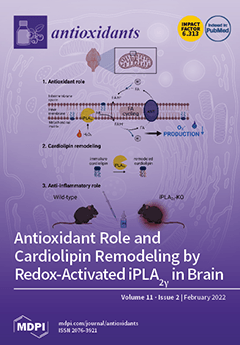Reactive oxygen species (ROS) are generated during intrinsic (chronological aging) and extrinsic (photoaging) skin aging. Therefore, antioxidants that inhibit ROS production may be involved in delaying skin aging. In this study, we investigated the potential effects of compounds isolated from black ginger,
Kaempferia parviflora, a traditional medicinal plant, on normal human dermal fibroblasts in the context of inflammation and oxidative stress. The isolated compounds were structurally characterized as 5-hydroxy-7-methoxyflavone (
1), 3,7-dimethoxy-5-hydroxyflavone (
2), 5-hydroxy-3,7,3,4-tetramethoxyflavone (
3), 7,4-dimethylapigenin (
4), 3,7,4-trimethylkaempferol (
5), and 3,5,7-trimethoxyflavone (
6), using nuclear magnetic resonance spectroscopy (NMR) and liquid chromatography–mass spectrometry (LC/MS) analyses. These flavonoids were first evaluated for their ability to suppress extracellular matrix degradation in normal human dermal fibroblasts. Of these, 3,5,7-trimethoxyflavone (
6) significantly inhibited the tumor necrosis factor (TNF)-α-induced high expression and secretion of matrix metalloproteinase (MMP)-1 by cells. We further found that 3,5,7-trimethoxyflavone suppressed the excessive increase in ROS, mitogen-activated protein kinases (MAPKs), Akt, and cyclooxygenase-2 (COX-2)and increased heme oxygenase (HO)-1 expression. The expression of pro-inflammatory cytokines, including interleukin (IL)-1β, IL-6, and IL-8, was also suppressed by 3,5,7-trimethoxyflavone (6). Taken together, our results indicate that 3,5,7-trimethoxyflavone (
6) isolated from
K. parviflora is a potential candidate for ameliorating skin damage.
Full article






